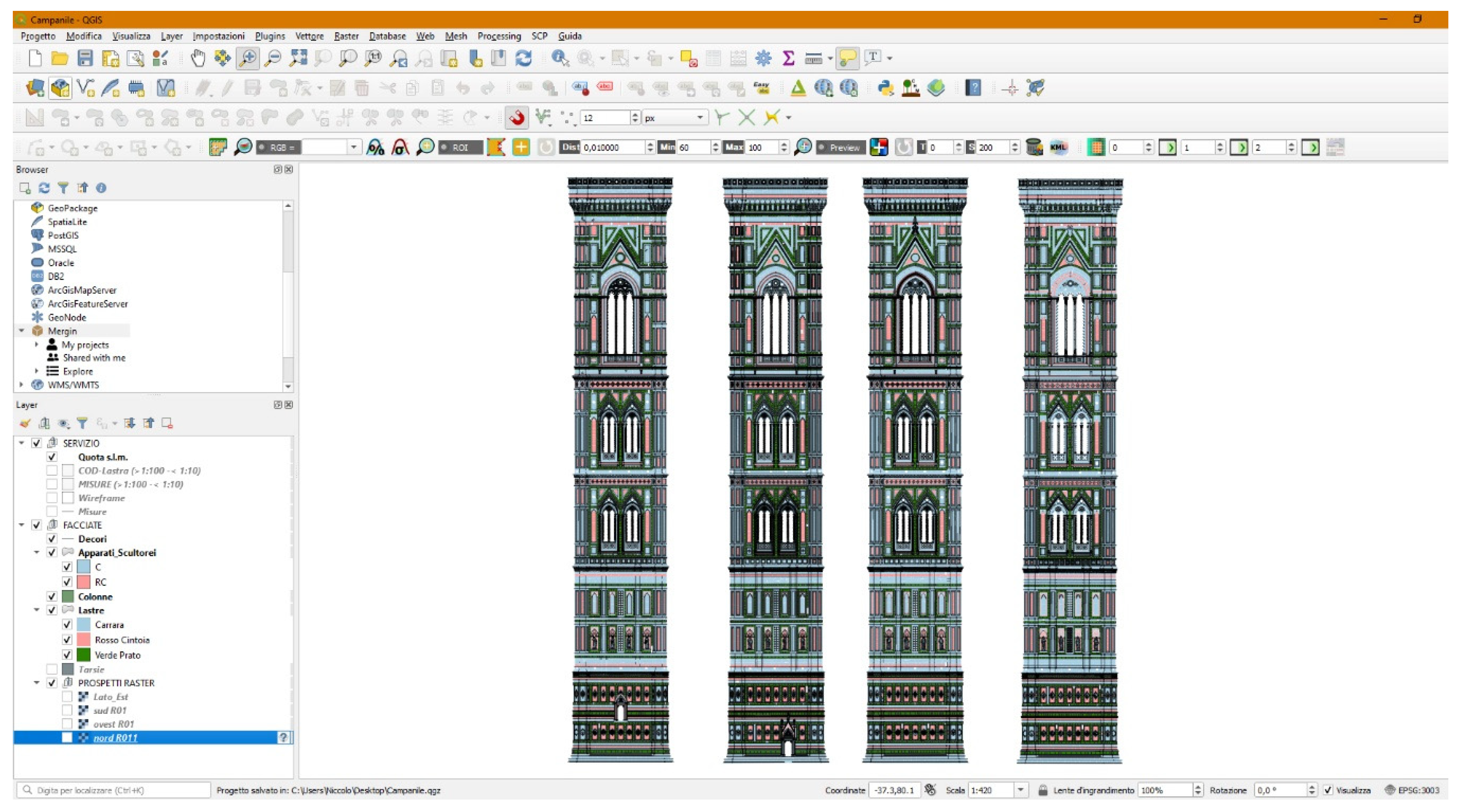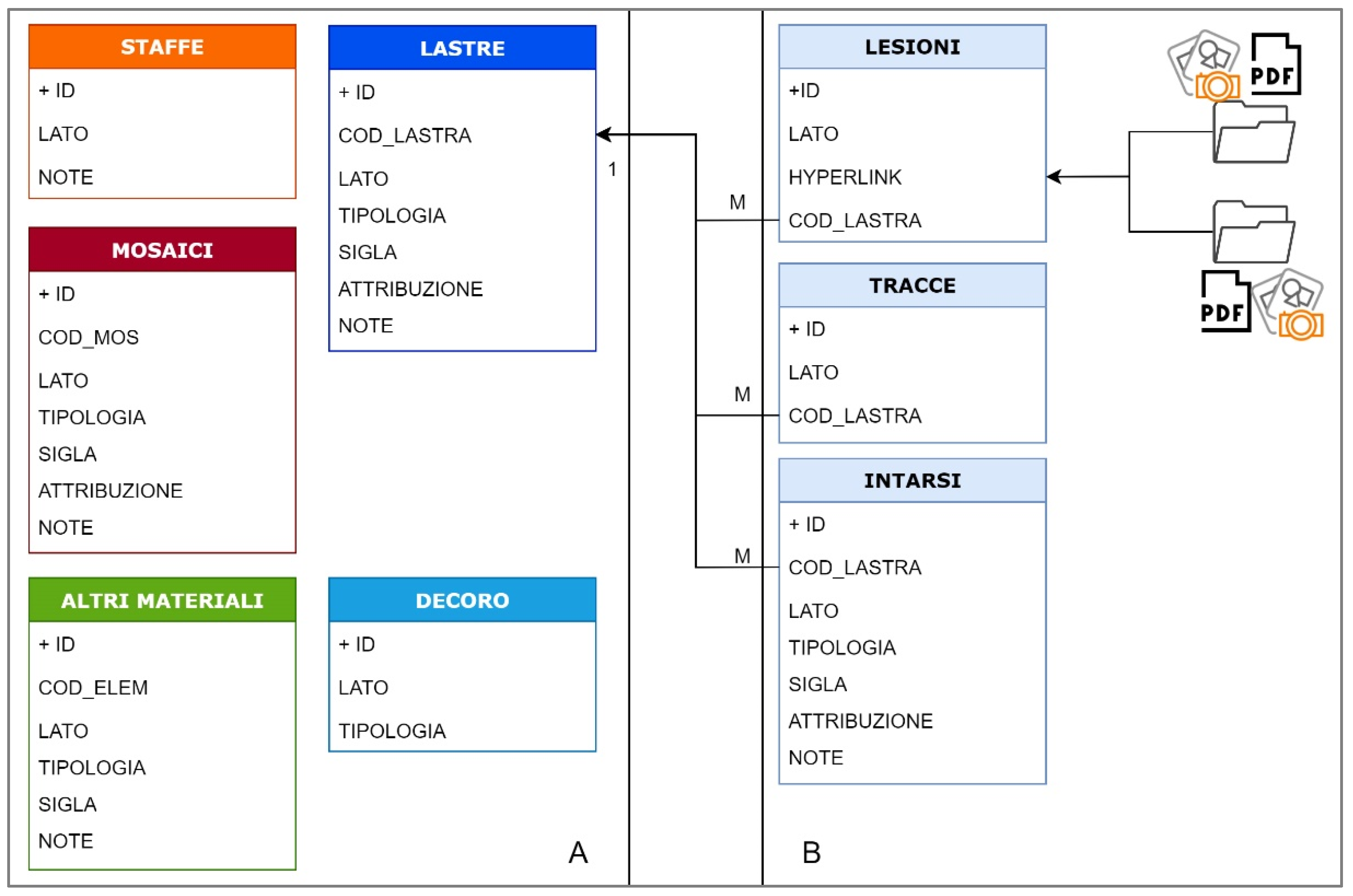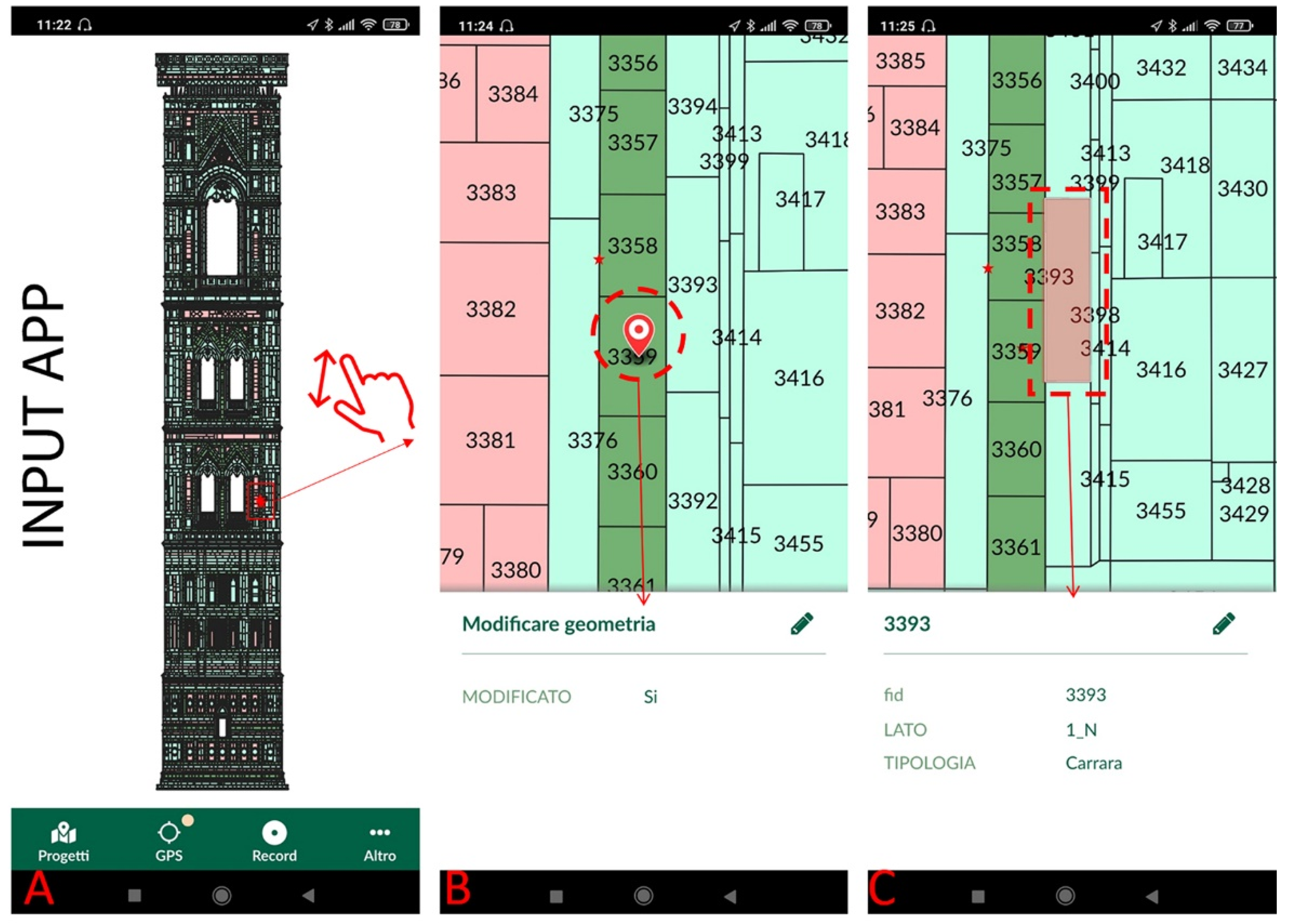An Unconventional Field Mapping Application: A Complete Opensource Workflow Solution Applied to Lithological Mapping of the Coatings of Cultural Heritage
Abstract
1. Introduction
2. Materials and Methods
- (a)
- Analysis of the previous information assets.
- (b)
- Planning of survey campaign.
- (c)
- Lithological survey and analysis of materials.
- (d)
- Definition of archiving criteria and procedures.
- (e)
- Choice of desktop and mobile platform.
- (a)
- Implementation of the information system (desktop).
- (b)
- Implementation of the monitoring and updating tool (mobile).
2.1. First Phase
- Organoleptic analysis carried out by experts based on their knowledge and concerning grain, texture and warp.
- Documentary analysis carried out on archives and historical texts that report orders, origin and type of materials.
- Technical analysis of petrographic, mineralogical, geochemical and isotopic order, which on the basis of international databases, allow to attribute the analyzed sample to that particular lithotype.
2.2. Second Phase
2.3. Third Phase
3. Implementation and Results
4. Discussion and Conclusions
- Unitary management of different data by themes, characteristics and form;
- Management of historical data and information, without having to resort to the examination of paper sources;
- Unique storage of data, thus avoiding errors related to non-unique encodings or data processing carried out by different operators;
- Ease and speed of simultaneous and integrated consultation of a large amount of data, their functional query to needs and their comparison (Figure 3);
- Possibility of customization according to specific graphic and documentary query needs;
- Possibility of data processing;
- Possibility of updating and further implementation in the phases following the design phase;
- Intangibility of data with results deriving from the monitoring phase.
- Table data typed in a spread-sheet: use the point or the comma for the decimal digits; define a priori the cell formats and keep them in the different files; do not use merged cells, enter up to 30 characters for each cell.
- CAD data: define and maintain a single digitization verse (clock- or counter-clockwise); pay attention in the closure of polygons (snap), attribute information to all elements; divide the various elements into separate layers; maintain consistency between layers, filling hatch, and legends, avoid blockages, clean up layers.
- File *.pdf: allow opening, printing and file management, without resorting to passwords or permissions in order to use the file in the most appropriate way for the case.
- External data computerization: in order to implement/analyze, as much as possible, proprietary data should be provided in open or adequate digital format (not as images or *.pdf) so that they can be managed with dedicated and appropriate software.
- When a raster data is converted into vector (*.shp) it important to have both the data: the original raster is under the responsibility of the extensor, the correct transposition in *.shp is under the responsibility of the operator.
Author Contributions
Funding
Institutional Review Board Statement
Informed Consent Statement
Conflicts of Interest
References
- UNESCO. Convenction Concerning the Protection of the World Cultural and Natural Heritage. United Nation Educational, Scientific and Cultural Organization, 1972. Available online: http://whc.unesco.org/en/conventiontext/ (accessed on 1 January 2021).
- Box, P. GIS and Cultural Resource Management. A Manual for Heritage Managers, 1st ed.; UNESCO Principal Regional Office for Asia and the Pacific: Bangkok, Thailand, 1999. [Google Scholar]
- Kutasi, D.; Vidovszky, I. The cost effectiveness of continuous maintenance for monuments and historic buildings. Period. Polytech. Archit. 2010, 41, 57–61. [Google Scholar] [CrossRef]
- Van Balen, K.; Vandesande, A. Reflections on Preventive Conservation, Maintenance and Monitoring by the PRECOM3OS UNESCO Chair, 1st ed.; Acco Uitgeverij: Belegie, Holland, 2013. [Google Scholar]
- Xiao, W.; Mills, J.; Guidi, G.; Rodrìguez-Gonzàlves, P.; Barsanti, S.G.; Gonzàlez-Aguilera, D. Geoinformatics for the conservation and promotion of cultural heritage in support of UN sustainable development goals. ISPRS J. Photogramm. Remote Sens. 2018, 142, 389–406. [Google Scholar] [CrossRef]
- Agapiou, A.; Lysandrou, V.; Alexakis, D.D.; Themistocleous, K.; Cuca, B.; Argyriou, A.; Sarris, A.; Hadjimitsis, D.G. Cultural heritage management and monitoring using remote sensing data and GIS: The case study of Paphos area, Cyprus. Comput. Environ. Urban. Syst. 2015, 54, 230–239. [Google Scholar] [CrossRef]
- Ortiz, R.; Ortiz, P.; Martìn, J.M.; Vàzquez, M.A. A new approach to the assessment of flooding and dampness hazards in cultural heritage, applied to the historic centre of Seville (Spain). Sci. Total Environ. 2016, 551, 546–555. [Google Scholar] [CrossRef] [PubMed]
- Vacca, G.; Fiorino, D.R.; Pili, D.A. Spatial Information System (SIS) for the Architectural and Cultural Heritage of Sardinia (Italy). ISPRS Int. J. Geo Inf. 2018, 7, 49. [Google Scholar] [CrossRef]
- Bertocci, S.; Bini, M. Manuale di Rilievo Architettonico e Urbano; CittàStudi.: Novara, Italy, 2012. [Google Scholar]
- Docci, M.; Maestri, D. Manuale di Rilevamento Architettonico e Urbano (Grandi opere); Laterza: Roma, Italy, 1994. [Google Scholar]
- Lezzerini, M.; Antonelli, F.; Colombu, S.; Gadducci, R.; Marradi, A.; Miriello, D.; Parosi, L.; Secchiari, L.; Lazzeri, A. Cultural Heritage Documentation and Conservation: Three-Dimensional (3D) Laser Scanning and Geographical Information System (GIS) Techniques for Thematic Mapping of Facade Stonework of St. Nicholas Church (Pisa, Italy). Int. J. Archit. Herit. 2016, 10, 9–19. [Google Scholar] [CrossRef]
- Pancani, G.; Bigongiari, M. Digital survey for the structural analysis of the Verruca fortress. Procedia Struct. Integr. 2020, 29, 149–156. [Google Scholar] [CrossRef]
- Cavalagli, N.; Gioffrè, M.; Grassi, S.; Gusella, V.; Pepi, C.; Volpi, G.M. On the accuracy of UAV photogrammetric survey for the evaluation of historic masonry structural damages. Procedia Struct. Integr. 2020, 29, 165–174. [Google Scholar] [CrossRef]
- Coli, M.; Marino, L. (2008) Principles of the natural stone use and practices from the western side of the Silk-road. In Proceedings of the International Symposium “Conservation of Ancient Sites” 2008 & ISRM-Sponsored Regional Symposium, Beijing, China, 22–24 September 2008; pp. 35–44, ISBN 978-7-03-027158-7. [Google Scholar]
- Rodolico, F. Le Pietre Delle Città d’Italia; Le Monnier: Firenze, Italy, 1965. [Google Scholar]
- Malesani, P.; Pecchioni, E.; Cantisani, E.; Fratini, F. Geolithology and provenance of materials of some historical buildings and monuments in the centre of Florence (Italy). Episodes 2003, 26, 250–255. [Google Scholar] [CrossRef] [PubMed]
- Fratini, F.; Rescic, S. The stone materials of the historical architecture of Tuscany, Italy. Geol. Soc. (Spec. Pubblications) 2013, 391, 71–92. [Google Scholar] [CrossRef]
- Garzonio, C.A.; Cantisani, E.; Coli, M.; Cuzman, O.; De Luca, D.; Lubritto, C.; Ricci, M.; Vettori, S.; Sibilia, E. I materiali costruttivi del Battistero. In Il Battistero di San Giovanni: Conoscenza, Diagnostica, Conservazione, Firenze, Italy, 24–25 November 2014; Mandragora: Firenze, Italy, 2017. [Google Scholar]
- Coli, M.; Donigaglia, T.; Tanganelli, M. Historical construction materials at Firenze (Itali): A selected supply at km 0. In Proceedings of the VI International Conference ReUSO, Messina, Italy, 11–13 October 2018. [Google Scholar]
- Sartori, R. Pietre e Marmi di Firenze; Alinea: Firenze, Italy, 2002. [Google Scholar]
- Salvatici, T.; Calandra, S.; Centauro, I.; Pecchioni, E.; Intrieri, E.; Garzonio, C.A. Monitoring and evaluation of sandstone decay adopting Non-Desctructive techniques:on-site applications on buildings stones. Heritage 2020, 3, 1287–1301. [Google Scholar] [CrossRef]
- Coli, M.; Donigaglia, T.; Papeschi, P.; Boscagli, F.; Agostini, B.; Caselli, G. GPS Applications for NDT Investigations on the Cultural Heritage Monumental Buildings of Florence (Italy). J. Civ. Eng. Arch. 2019, 13, 415–426. [Google Scholar] [CrossRef]
- Vasconcelos, G.; Lourenço, P.B.; Alves, C.A.S.; Pamplona, J. Ultrasonic evaluation of the physical and mechanical properties of granites. Ultrasonics 2008, 48, 453–466. [Google Scholar] [CrossRef] [PubMed]
- Akoglu, K.G.; Kotoula, E.; Simon, S. Combined use of ultrasonic pulse velocity (UPV) testing and digital technologies: A model for long–term condition monitoring memorials in historic Grove Street Cemetery, New Haven. J Cult. Herit. 2019, 41, 84–95. [Google Scholar] [CrossRef]
- Burrough, P.A.; McDonnell, R. Principles of Geographical Information Systems; Oxford University Press: Oxford, UK, 1998. [Google Scholar]
- QGIS. Available online: https://qgis.org/it/site/ (accessed on 12 January 2021).
- Ostadabbas, H.; Weippert, H.; Behr, F.J. Using the synergy of QFIELD for collecting data on-site and QGIS for interactive map creation by ALKIS® data extraction and implementation in PostgreSQL for urban planning process. Int. Arch. Photogramm. Remote Sens. Spatial. Inf. Sci. 2020, XLIII-B4-2020, 679–683. [Google Scholar] [CrossRef]









| Field Name | Field Type and Values |
|---|---|
| DESCRIPTION | 10.920 |
| PHOTO | 9.701 |
| PHOTO NUMBER | 1.256 |
| NOTE | 584 |
| Types of Materials | Number of “lastre” |
|---|---|
| Verde Prato | 10.920 |
| Carrara Marble | 9.701 |
| Imetto | 1.256 |
| Lasa Marble | 584 |
| Punta Bianca Marble | 315 |
| Pentelico | 147 |
| Apuana Slate | 51 |
| Porfido Rosso Antico | 9 |
| Verde Malenco | 4 |
| Porfido Verde Antico | 2 |
| Calcescisto | 2 |
| Cipollino Rubrio dell’Eubea | 2 |
| Thassos | 1 |
| Breccia Greca Antica | 1 |
| Sienitic Granite | 1 |
| Types of Materials | Number of “lastre” |
|---|---|
| Carrara Marble | 27.273 |
| Verde Prato | 8.864 |
| Rosso Cintoia | 4.523 |
| Types of Materials | Number of “conci” |
|---|---|
| Alberese | 16.987 |
| Verde Prato | 7.993 |
| Palombino | 3.127 |
| Pietra Serena | 596 |
| Carrara Marble | 374 |
Publisher’s Note: MDPI stays neutral with regard to jurisdictional claims in published maps and institutional affiliations. |
© 2021 by the authors. Licensee MDPI, Basel, Switzerland. This article is an open access article distributed under the terms and conditions of the Creative Commons Attribution (CC BY) license (https://creativecommons.org/licenses/by/4.0/).
Share and Cite
Iandelli, N.; Coli, M.; Donigaglia, T.; Ciuffreda, A.L. An Unconventional Field Mapping Application: A Complete Opensource Workflow Solution Applied to Lithological Mapping of the Coatings of Cultural Heritage. ISPRS Int. J. Geo-Inf. 2021, 10, 357. https://doi.org/10.3390/ijgi10060357
Iandelli N, Coli M, Donigaglia T, Ciuffreda AL. An Unconventional Field Mapping Application: A Complete Opensource Workflow Solution Applied to Lithological Mapping of the Coatings of Cultural Heritage. ISPRS International Journal of Geo-Information. 2021; 10(6):357. https://doi.org/10.3390/ijgi10060357
Chicago/Turabian StyleIandelli, Niccolò, Massimo Coli, Tessa Donigaglia, and Anna Livia Ciuffreda. 2021. "An Unconventional Field Mapping Application: A Complete Opensource Workflow Solution Applied to Lithological Mapping of the Coatings of Cultural Heritage" ISPRS International Journal of Geo-Information 10, no. 6: 357. https://doi.org/10.3390/ijgi10060357
APA StyleIandelli, N., Coli, M., Donigaglia, T., & Ciuffreda, A. L. (2021). An Unconventional Field Mapping Application: A Complete Opensource Workflow Solution Applied to Lithological Mapping of the Coatings of Cultural Heritage. ISPRS International Journal of Geo-Information, 10(6), 357. https://doi.org/10.3390/ijgi10060357







